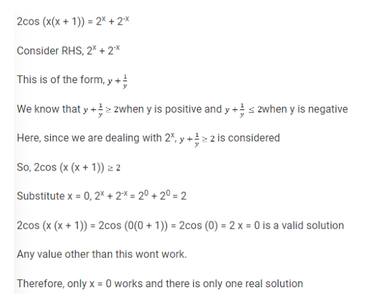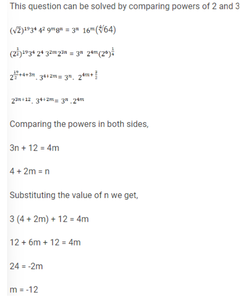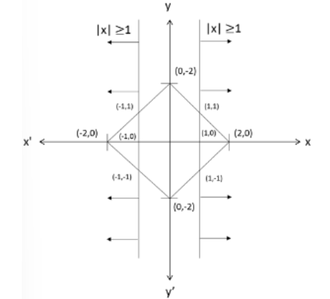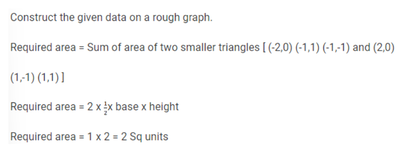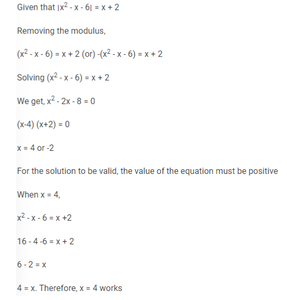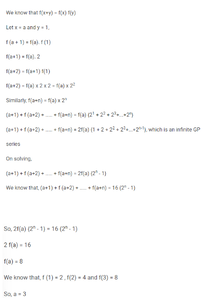Q1. The number of the real roots of the equation 2cos(x(x + 1)) = 2x + 2-x is
The number of integers n that satisfy the inequalities |n - 60| < |n - 100| < |n - 20| is
21
18
20
19
Answer :-
|n - 60| < |n - 100| < |n - 20|
To solve this question, we need to know the basic concept that ‘if x and y are two points on the number line, then the distance between these two points can be represented by |x - y| or |y - x|.’
Let's take the first part of the inequality
|n - 60| < |n - 100|
This inequality holds good for the values of n below 80. So this is the turning point.
Hence ‘n’ should be less than 80.
Now Let's check for the later part of the inequality.
|n - 100| < |n - 20|
This inequality holds good for the values of n above 60. So, 60 is the turning point here.
Hence ‘n’ should be greater than 60.
Therefore, the values of ‘n’ range from 61 to 79.
So, the total possible integers that satisfy this inequality are 19.
If log2[3 + log3{4 + log4(x - 1)}] - 2 = 0 then 4x equals
Sir, Yeh thik hai?
log2[3+log3{4+log4(x-1)}]- 2= 0
log2[3 + log3{4 + log4(x - 1)}] = 2
3 + log3{4 + log4(x - 1)} = 4 ( ∵ logaN = x ⇒ N = ax )
log3{4 + log4(x - 1)} = 1
4 + log4(x - 1) = 3
log4(x - 1) = -1
x - 1 = 1/4
4x = 5
Q1. Let S be the set of all points (x,y) in the x-y plane such that
|x| + |y| ≤ 2 and |x| ≥ 1. Then, the area, in square units, of the region represented by S equals ?
Since we have cancelled y in our first step, x = 0 is also a solution
So, Number of possible solutions = 4 + 1 = 5
@neraj-naiyar Sir,
For x = -2,
x2 - x - 6 = x +2
4 + 2 - 6 = x + 2
0 - 2 = x
-2 = x. Therefore, x = - 2 works
Similarly, Solving -(x2 - x - 6) = x + 2
-x2 + x + 6 = x + 2
x2 = 4
x = +2 or -2
For the solution to be valid, x2 - x - 6 must be negative
When x = +2,
-x2 + x + 6 = x +2
-4 + 2 + 6 = x + 2
+ 2 = x Therefore, x = 2 works.
Therefore, Product of distinct roots = 2 x -2 x 4 = -16
Q1. A is the average of 10 given numbers. B is the average after 2 of the numbers were replaced by 3 other different numbers. The average of the removed nu0mbers is 48 and the average of the newly included numbers is 56. If A + B = 438, then the value of A - B is:
(a) 21
(b) 14
(c) 12
(d) 26
Sol.2 (b)
Total sum of 10 number = 10A
According to the question,
⇒ (-48 × 2) + (3 × 56) + (sum of rest of number) = 11B
Then, 11B - 10A = 72 ... (i)
Given that, A + B = 438 ..... (ii)
Solving on Eq (i) and Eq(ii) we get,
B = 212 and A 226.
So, A - B = 14
Q1. What is the square of root of 99999 ?
A) 316.23
B) 316.22
C) 316.21
D) 316.20
In the expansion of (a + b + c)20, find
A.Number of terms?
B. Sum of the coefficients
Q.4 What is cube root of 55555:-
A) 38.17
B) 38.16
C) 38.15
D) 38.14
If a + b + c = 6, find the maximum value of a3b2c, where all a, b and c are positive real
numbers.
As i checked all the conversions are very informative , Thank you for your solutions.
Both x2 + 16x – q = 0 and x2 – 11qx + 25 = 0 have real roots. The number of positive integral values of q is _____ .
A. 39 B.70 C. 60 D. 64
The equation 5x + 7y = k has 7 solutions in which both x, y are non-negative integers. What is the minimum value of k?
A. 210 B. 280 C. 223 D. 290
The sum of the first eight terms of a geometric progression is 510 and the sum of the first four terms of the geometric progression is 30. Find the first term of the geometric progression, given that it is positive.


